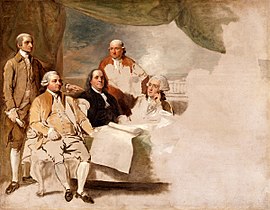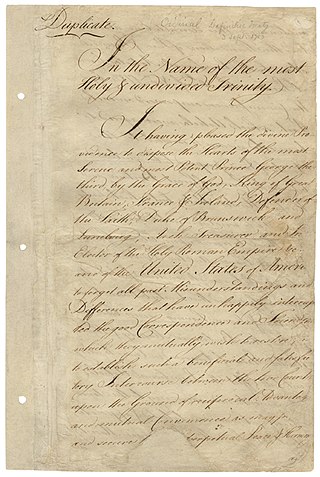
The Treaty of Paris, signed in Paris by representatives of King George III of Great Britain and representatives of the United States on September 3, 1783, officially ended the American Revolutionary War and state of conflict between the two countries and acknowledged the Thirteen Colonies, which had been part of colonial British America, as an independent and sovereign nation.
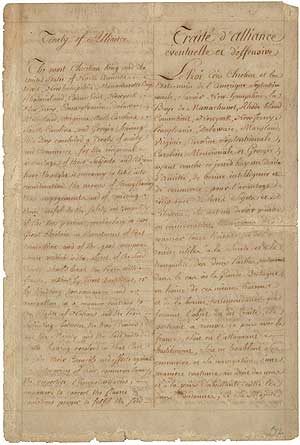
The Treaty of Alliance, also known as the Franco-American Treaty, was a defensive alliance between the Kingdom of France and the United States formed amid the American Revolutionary War with Great Britain. It was signed by delegates of King Louis XVI and the Second Continental Congress in Paris on February 6, 1778, along with the Treaty of Amity and Commerce and a secret clause providing for the entry of other European allies; together these instruments are sometimes known as the Franco-American Alliance or the Treaties of Alliance. The agreements marked the official entry of the United States on the world stage, and formalized French recognition and support of U.S. independence that was to be decisive in America's victory.

Benjamin West, was a British-American artist who painted famous historical scenes such as The Death of Nelson, The Death of General Wolfe, the Treaty of Paris, and Benjamin Franklin Drawing Electricity from the Sky.

Liberty Displaying the Arts and Sciences, or The Genius of America Encouraging the Emancipation of the Blacks (1792) is an oil-on-canvas painting by the American artist Samuel Jennings. Held in the permanent collection of the Library Company of Philadelphia, this work is the earliest known American painting promoting abolitionism in the United States.

French involvement in the American Revolutionary War of 1775–1783 began in 1776 when the Kingdom of France secretly shipped supplies to the Continental Army of the Thirteen Colonies when it was established in June 1775. France was a long-term historical rival with the Kingdom of Great Britain, from which the Colonies were attempting to separate.

The Model Treaty, or the Plan of 1776, was a template for commercial treaties that the United States planned to make with foreign powers during the American Revolution against Great Britain. It was drafted by the Continental Congress to secure economic resources for the war effort, and to serve as an idealistic guide for future relations and treaties between the new American government and other nations. The Model Treaty thus marked the revolution's turning point towards seeking independence, and is subsequently considered a milestone in U.S. foreign relations.

William Temple Franklin Jr, known as Temple Franklin, was an American diplomat and real estate speculator who is best known for his involvement with the American diplomatic mission in France during the American Revolutionary War. Beginning at the age of 16, he served as secretary to his grandfather Benjamin Franklin, who negotiated and agreed to the Franco-American Alliance.
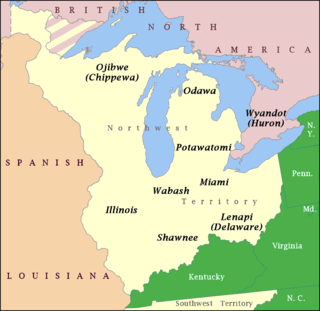
The Northwestern Confederacy, or Northwestern Indian Confederacy, was a loose confederacy of Native Americans in the Great Lakes region of the United States created after the American Revolutionary War. Formally, the confederacy referred to itself as the United Indian Nations, at their Confederate Council. It was known infrequently as the Miami Confederacy since many contemporaneous federal officials overestimated the influence and numerical strength of the Miami tribes based on the size of their principal city, Kekionga.

The Peace of Paris of 1783 was the set of treaties that ended the American Revolutionary War. On 3 September 1783, representatives of King George III of Great Britain signed a treaty in Paris with representatives of the United States of America—commonly known as the Treaty of Paris (1783)—and two treaties at Versailles with representatives of King Louis XVI of France and King Charles III of Spain—commonly known as the Treaties of Versailles (1783). The previous day, a preliminary treaty had been signed with representatives of the States General of the Dutch Republic, but the final treaty which ended the Fourth Anglo-Dutch War was not signed until 20 May 1784; for convenience, however, it is included in the summaries below.
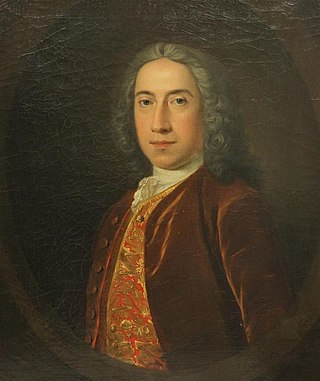
Richard Oswald was a Scottish merchant, slave trader and diplomat. During the American Revolution, he served as an advisor to the North ministry on trade regulations and the best way to response to the American War of Independence. Oswald is best known for being one of the British peace commissioners who negotiated the Peace of Paris in 1782.
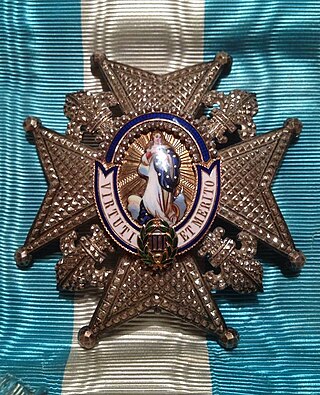
Joseph-Mathias Gérard de Rayneval, was a French diplomat and government minister of the Ancien Régime.
Diplomacy in the Revolutionary War had an important impact on the Revolution, as the United States evolved an independent foreign policy.

The Diplomatic Reception Rooms at the U.S. Department of State constitute forty-two principal rooms and offices where the secretary of state conducts the business of modern diplomacy. Located on the seventh and eighth floors of the Harry S Truman Building in Washington, D.C., the diplomatic reception rooms contain one of the nation’s foremost museum collections of American fine and decorative arts.

Joseph Wright was an American portrait painter and sculptor. He painted life portraits of George Washington and Benjamin Franklin, and was a designer of early U.S. coinage. Wright was President Washington's original choice for Chief Engraver of the U.S. Mint, but died at age 37, before being confirmed to that position.
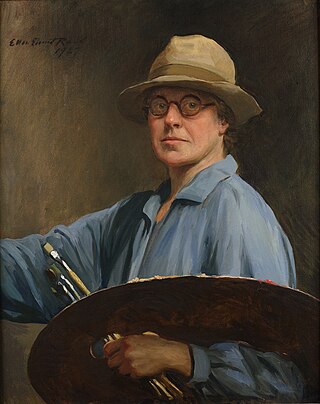
Ellen Emmet Rand was a painter and illustrator. She specialized in portraits, painting over 500 works during her career including portraits of President Franklin D. Roosevelt, artist Augustus Saint-Gaudens, and her cousins Henry James and William James. Rand studied at the Cowles Art School in Boston and the Art Students League in New York City and produced illustrations for Vogue Magazine and Harper's Weekly before traveling to England and then France to study with sculptor Frederick William MacMonnies. The William Benton Museum of Art at the University of Connecticut owns the largest collection of her painted works and the University of Connecticut, as well as the Archives of American Art within the Smithsonian Institution both have collections of her papers, photographs, and drawings.

Washington at Verplanck's Point is a full-length portrait in oil painted in 1790 by the American artist John Trumbull of General George Washington at Verplanck's Point on the North River in New York during the American Revolutionary War. The background depicts the September 14, 1782 review of Continental Army troops Washington staged there as an honor for the departing French commander Comte de Rochambeau and his army.
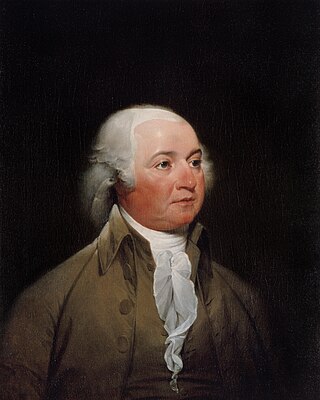
John Adams (1735–1826) was an American Founding Father who served as one of the most important diplomats on behalf of the new United States during the American Revolution. He served as minister to the Kingdom of France and the Dutch Republic and then helped negotiate the Treaty of Paris to end the American Revolutionary War.

George Washington is a large full-length oil painted by American artist John Trumbull in 1790.

Captain John Purves and His Wife, Eliza Anne Pritchard, is an oil-on-canvas portrait created by American painter Henry Benbridge (1743–1812). It was painted in Charleston, South Carolina, in 1775. A bequest from Henry Francis du Pont, the painting is held in the permanent collection of the Winterthur Museum, Garden and Library.
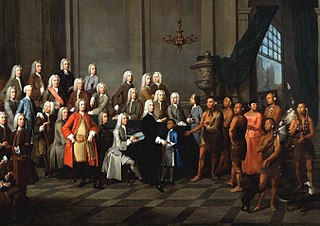
Audience Given by the Trustees of Georgia to a Delegation of Creek Indians is an oil-on-canvas group portrait created by English painter William Verelst (1704–1752). It was painted in London in 1734 or 1735. A bequest from Henry Francis du Pont, the painting is held in the permanent collection of the Winterthur Museum, Garden and Library. The painting depicts a Creek Yamacraw delegation, including Tomochichi, meeting with the governing body of the English Province of Georgia.
